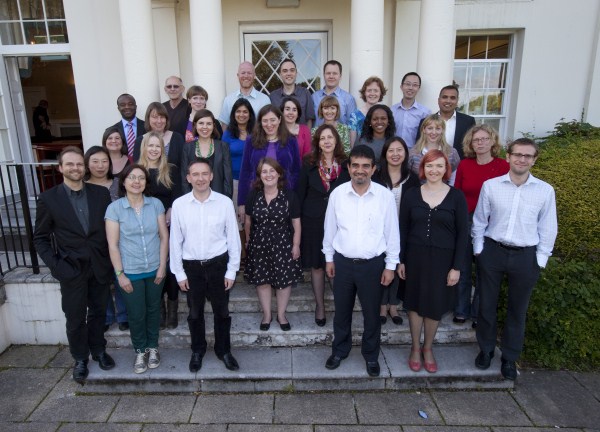
Sketty Hall, Swansea, June 2012
The Second Welsh Crucible
Thirty successful applicants were selected in March 2012 for the second Welsh Crucible. The formal part of the programme took place at three intensive two-day workshops (called ‘labs’) in Cardiff, Swansea and Bangor during the summer of 2011.

Emerging Collaborations
Since completing the programme participants on Welsh Crucible 2012 have worked together informally to develop ideas for potential interdisciplinary research collaborations. Some of the ideas now being taken forward include
‘ARMED: Automated Ruminant Methane Emission Detector’
Cattle and sheep (ruminants) produce significant greenhouse gas emissions, due to their fore-gut fermentation of plant material generating fermentation gas containing methane and carbon dioxide. Of these two gases methane is the biggest issue, due to it being 20 times more potent a greenhouse gas than carbon dioxide.
Current strategies to decrease ruminal methane production are primarily based on ruminant feed additives and/or dietary interventions. The ability to develop novel methane mitigation approaches, and assess their efficacy on farm, is however limited by the ability to make robust, accurate and cost-effective methane measurements in real-time. The aim of this project is to develop a novel electronic nose, or ‘e-Nose,’ to overcome these issues by enabling real-time vapour sensing. Like biological noses, this will contain an array of sensors based on a variety of technologies that use abundant materials. The materials are cheap to manufacture (so scalable for the mass-market) and are bio-degradable.
‘ReBot: A Research roBot that can read scientific papers’
Reading and understanding unfamiliar scientific papers is a common task when establishing new research collaborations. This is true not only for collaborating researchers from different disciplines (e.g., science vs. engineering), but also for those within the same discipline (e.g., micro-biology vs. mathematical-biology). This project offers a solution – a research robot that processes scientific papers to aid their reading and understanding, thus significantly saving our precious time and effort.
The ultimate vision is application of ReBot on a multi-disciplinary scale. However, the first step is to demonstrate the working principles within a single academic discipline; for this we have chosen biology. This project combines perspectives of biologists (who will identify the structure of their scientific papers, what really matters in these papers and how to recognize it) with computer science and engineering theory and practice (e.g., machine learning, pattern recognition, artificial intelligence, data mining, programming).
‘All for Water’
Freshwater is a limited resource (less than 2.5% of all water). With increasing population pressures and more stringent water regulations, effective and efficient sewage treatment is a priority with respect to not only removing waste and recycling freshwater but also for reclaiming any useful nutrients (e.g., phosphorus, a declining resource, heavily required for agriculture). Our aim is to conduct preliminary examinations on how best to configure a novel waste-water treatment system for applications in handling various wastewater types and for water harvesting. This project combines expertise from civil and environmental engineering (treatment system design and construction), mathematics and biology (bacterial process modelling), electronic engineering (biosensor design), law (legal framework behind water monitoring and control) and psychology (public attitudes towards water use and conservation).
‘Transformative thinking: Using digital fiction as a tool for improving body image’
Can digital fiction help young women think in more empowered ways about their body image? Female body dissatisfaction is a significant problem, with a recent parliamentary report suggesting addressing this problem by reframing body image in terms of health not appearance. But, in everyday language ‘health’ is often used synonymously for ‘thinness’, reinforcing cultural ideals linked to negative body image. New frameworks for thinking positively about body image are therefore urgently needed.
This study will explore if such thinking can be developed through facilitated reading/playing of digital fiction. Digital fictions are hybrid forms of game-books that are read/played on-line. They are primarily entertainment, but some encourage the player/reader to think critically about body image issues. The proposed project fuses social science, humanities and media analysis in a novel way to develop bibliotherapy (the use of reading to help with psychological issues) in relation to electronic media.
‘Novel point-of-care testing for the early detection of human cytomegalovirus’
Human cytomegalovirus (HCMV) is a member of the herpes family of viruses and is spread through bodily fluids, including saliva, blood, breast milk, semen and urine. Over 90% of adults will be infected by HCMV at some point in their life. Once infected, the virus is carried within the person for life, but as long as people remain healthy, they do not show any symptoms. However, HCMV can result in serious health complications and even death for those with weak immune systems, such as patients with HIV and organ transplant recipients. It is a particular problem if caught by a woman during pregnancy, a problem affecting about 2% of babies. HCMV can cause permanent disabilities such as mental retardation or deafness, or even fatality, to their babies. Most infected babies are not diagnosed at birth because they do not show symptoms, however they can develop hearing or vision loss, or developmental problems, months or years later. Early detection of HCMV is critical to allow intervention as soon as possible, in order to minimise the long-term impact of these problems. This project seeks to develop novel nanobiosensors that will allow rapid detection of virus at very low concentrations. This will lead to the development of an ultra-sensitive, low-cost point-of-care diagnostic device for the rapid and accurate detection of HCMV. Such novel technology is suitable for large-scale screening programs, which are impractical with existing technology due to both cost and the requirements for trained laboratory staff and equipment.

